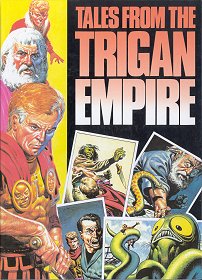The Trigan Empire facts for kids
Quick facts for kids The Rise and Fall of the Trigan Empire |
|
|---|---|

Tales From the Trigan Empire, 1989
|
|
| Created by | Mike Butterworth Don Lawrence |
| Publication information | |
| Publisher | |
| Formats | Original material for the series has been published as a strip in the comics anthology(s) Ranger and Look and Learn. |
| Original language | English |
| Genre | Science fiction |
| Publication date | September 1965 – April 1982 |
| Creative team | |
| Writer(s) | Mike Butterworth Ken Roscoe |
| Artist(s) | Don Lawrence Oliver Frey Gerry Wood Philip Corke Ramon Sola Ron Embleton Miguel Quesada |
| Reprints | |
| Collected editions | |
| The Look and Learn Book of the Trigan Empire (1973) | ISBN: 0-85037-104-X |
| The Trigan Empire (1978) | ISBN: 0-600-38788-7 |
| Tales from the Trigan Empire (1989) | ISBN: 0-948248-95-5 |
| The Trigan Empire (The Don Lawrence Collection) (2004-2008) (12 vols) | ISBN: 90-73508-54-1 |
| The Rise and Fall of The Trigan Empire (2020- ) | ISBN: 978-1-78108-755-8 |
The Rise and Fall of the Trigan Empire, also known as The Trigan Empire, is a science fiction comic series. It was mainly written by Mike Butterworth and featured amazing artwork by Don Lawrence. The comic tells the story of an alien world called Elekton. On Elekton, advanced technology like flying vehicles and energy weapons mixes with styles from ancient civilizations. Think of Ancient Greece and the Roman Empire!
The stories follow a brave hero who protects his empire from many dangers. The comic is famous for its unique art style. Don Lawrence used a painting-like look that made the characters and scenes feel very real.
Contents
Discovering the Trigan Empire
The comic series first appeared in magazines from 1965 to 1982. It shared tales from the distant planet Elekton. Many societies on Elekton were inspired by ancient Earth cultures. The main one, the Trigan Empire, was much like ancient Greece and Rome.
Even the capital city, Trigan City, was built on five hills, similar to Rome's seven hills. The Trigans wore clothes like Roman togas and their soldiers had Greek or Roman-style armor. They also flew advanced airships! Another group, the Hericons, looked like people from the Byzantine Empire or the Persian Empire.
The idea for the comic came from Leonard Matthews, an editor. He gave Mike Butterworth the first script and told him to continue the story.
How the Story Began
The first comic strip starts with a spaceship crashing on Earth. The crew inside are frozen, and the ship is full of books in a strange language. The crew members are human-like but very tall, about 12 feet!
Years later, the spaceship becomes a popular attraction at an amusement park. A scientist named Peter Richard Haddon, who studied the books when he was young, finally translates them. He then begins to share the amazing stories of the Trigan Empire.
The Rise of the Trigans
The Trigans started as a group of nomads called the Vorgs. They had no technology and were led by three brothers: Trigo, Brag, and Klud. Trigo convinced his brothers that they needed to settle down. This was important because the Lokan Empire was becoming a threat.
The new Trigan nation was formed when the nomadic Vorgs joined with the advanced people of Tharv. The Tharv people had become refugees after being defeated by the Lokans. Trigo became their leader. The Trigans adopted a Roman-like style with swords and armor. But they also had high-tech ray guns, aircraft, and a modern navy. In one story, they even built a rocketship in just a few months to fly to one of Elekton's moons! Many other civilizations on Elekton also mixed old and new technologies.
Creative Minds Behind the Series
Many talented people worked on The Trigan Empire over the years.
Writers
- Mike Butterworth
- Ken Roscoe
Artists
- Don Lawrence (1965-1973, 1975-1976)
- Ron Embleton (1969, 1968/1975)
- Miguel Quesada (1972, 1974)
- Philip Corke (1974-1975)
- Oliver Frey (1976-1977)
- Gerry Wood (1977-1982)
- Henry Winter
Collected Editions
The stories of The Trigan Empire have been gathered into several book collections over time. This allows new readers to enjoy the adventures. Some of these collections include:
- The Look and Learn Book of the Trigan Empire (1973)
- The Trigan Empire (1978)
- Tales from the Trigan Empire (1989)
- The Trigan Empire (The Don Lawrence Collection) (2004-2008, 12 volumes)
- The Rise and Fall of The Trigan Empire (starting 2020)
Other Forms of the Story
The Trigan Empire stories have also been adapted into other forms of media.
- Two radio plays were made in Dutch: "The Mysterious Meteorite" and "Lumbwabwa the Usurper".
- In 2009, movie rights were bought for a film based on the comic. By 2011, a script was ready, and producers were looking for a director.
- A TV series was being developed in 2017 with 10 episodes written. However, production stopped when Rebellion Developments bought the rights to the comic.
Images for kids
See also
 In Spanish: El Imperio de Trigan para niños
In Spanish: El Imperio de Trigan para niños


